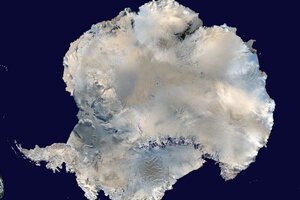China to bolster presence in Antarctica, build fourth research station
China is expanding its presence in the resource-rich continent, a possible sign that it could be gearing up for a power play in future negotiations over how to manage the region's oil and minerals, analysts say.

China is planning to add a fourth research station to its roster of bases on the continent.
NASA/Reuters
Just days after the Chinese rover Jade Rabbit settled down on the moon, China is setting out to bolster its presence in another remote place: Antarctica.
Chinese state media said on Thursday that construction workers are en route to the future site of China’s fourth Antarctic research station, after a pit stop at one of its other bases. The new station will be a hub for climate change science – as well as a possible linchpin in China’s effort to ensure for itself a voice in future negotiations about Antarctica’s valuable natural resources, analysts say.
China is a relative latecomer to the coldest continent. It did not put its first base, called Great Wall, on Antarctica’s King George Island until 1985. The US, Russia, Argentina, and the UK had maintained multiple bases there for decades.
But China has since been investing in the continent with a speed not unlike the quickness with which it has sought to match Russia and the US’s accomplishments in the cosmos. Its second Antarctic base, Zhongshan Station, was put on East Antarctica’s Larsemann Hills in 1989, and it added a third base, Kunlun – the state’s first inland station – atop East Antarctica’s hard-to-reach Dome A in 2009. China’s Polar Research Institute has been on something of a hiring spree, advertising some 47 new positions in 2012.
"As a latecomer to Antarctic scientific research, China is catching up," Qu Tanzhou, director of the State Oceanic Administration's Chinese Arctic and Antarctic Administration, told Xinhua, China’s state news agency.
The Antarctic Treaty – signed by twelve countries in December 1959, and by China in 1983, since cold war politics delayed China's participation – establishes the continent as a “global common,” in that all states can use it (seven states, China not among them, do have sovereignty claims on the continent, though). Antarctica is thought to be brimful with coal, oil, and various minerals, including iron and copper. But, under the Protocol on Environmental Protection to the Antarctic Treaty, signed in 1991, all mining is prohibited in the region. Just about all that countries are allowed to do there is science.
That protocol, though, is up for renegotiation in 2048. That has meant that states with prospective interests in the resource-rich region have sought to guarantee a voice in future negotiations by ensuring that they have a literal investment there: a scientific base, the bargaining chip of a region where science is supreme.
“The new base will consolidate China's presence in East Antarctica,” says Anne-Marie Brady, a researcher at the Wilson Center, in Washington DC, who is currently writing a book on China's polar strategy.
“China is playing a long game in Antarctica,” she says, “as are a number of other states such as Korea, India, Russia, who have explicitly stated their interest in Antarctic mineral resources.”
China’s obvious interest in Antarctica has stirred up “anxiety and fear” amongst the some 30 states with bases in Antarctica, says Klaus Dodds, a professor of Geopolitics at the University of London and an expert in polar governance.
“Geopolitically, Antarctica is viewed by China as a territory that might become increasingly significant,” he says. “There are concerns that it might be increasingly positioning itself to act decisively.”
Still, China’s increasing participation in the region’s affairs has so far suggested a willingness to play by the rules there, says Dr. Dodds.
“China is becoming more active within the Antarctic Treaty System and this might be seen as welcome evidence of 'buy-in' to the norms, principles, and practices of this longstanding international regime,” says Dodds.
The new station, called Taishan, will be built at East Antarctica’s Princess Elizabeth Land, between the state’s Zhongshan and Kunlan camps. China’s mammoth icebreaker, a bright red ship called The Snow Dragon, had left China for Antarctica last month, bearing the construction materials to put together the new station.
The station will be shaped like a Chinese lantern, Xinhua said.
[Editor's Note: An earlier version of this article misstated the terms of The Antarctic Treaty. It allows states to claim sovereignty on the continent, while also allowing other states to treat the space as a global commons. The article also misstated Dr. Klaus Dodds' name. It is Dodds, not Dodd.]

